Can You Use Carton Coconut Milk Instead Of Canned?

I adore all things coconut, and I really enjoy cooking Thai cuisine; but I’m curious if coconut milk in a can is the same as coconut milk in a carton.
I checked into it and found the following:
Coconut milk from a can is not the same as coconut milk from a carton. Despite both starting with coconut and water as the primary ingredients, the most significant difference between canned and carton coconut milk is that carton coconut milk has additional fillers and is watered down quite a bit more.
Carton coconut milk is far more watery, lower in fat, and less flavorful than canned coconut milk as a result of this. However, this is also why canned coconut milk costs so much more per ounce.
But there’s a lot more to know about coconut milk, including whether the canned variety should be used in your next curry.
So let’s get this party started!
What is coconut milk, and how is it produced?
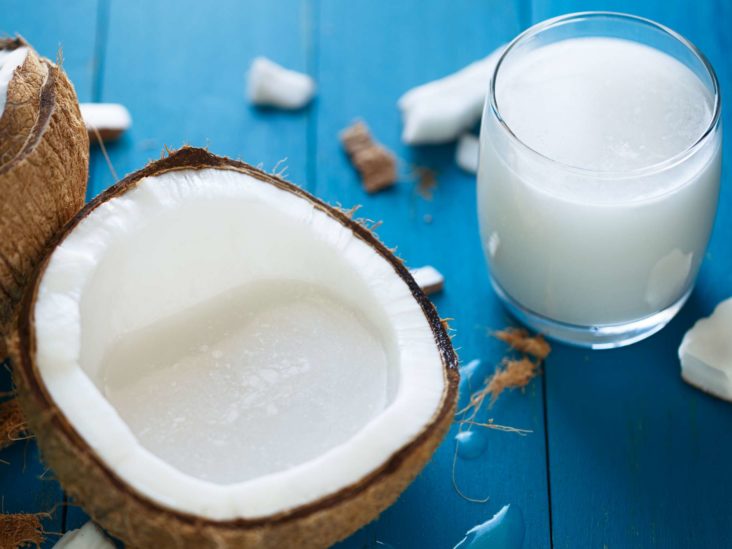
Coconut milk is a flavorful, somewhat sweet, creamy liquid derived from the meat of a coconut. Coconut milk is not to be confused with coconut water, which is the juice of coconut.
The meat is shredded and puréed with water, then filtered through cheesecloth to form canned coconut milk. It can, for example, then be used in several Thai soups and curries.
Canned coconut milk differs from the kind sold in a carton in the dairy area, as we’ll discuss further below. Coconut milk in a carton is often used as a non-dairy milk substitute in smoothies, coffee creamer, and porridge. It’s commonly located in your supermarket’s refrigerated department and is usually substantially less expensive. In most cases, coconut milk in a carton will have more than just “coconut milk” listed in the ingredients. Thickeners, sweeteners, and other additives may be included.
Which coconut milk should you purchase? What about a dollop of coconut cream?
You’ve got some inquiries, and we’ve got the answers you’re looking for.
Can I use canned coconut milk instead of carton coconut milk?
The quick answer is no and it isn’t really the same in taste and even in texture. Coconut milk in a carton is a non-dairy beverage that can be found in the dairy area of your grocery store with other non-dairy kinds of milk. It can be sweetened and used in the same way as conventional milk.
You can drink it straight, mix it into cereal, or add it to coffee. For general cooking and baking, coconut milk in a carton can be used as a substitute for dairy milk. It should not, however, be used in place of canned coconut milk. Coconut milk in a can and coconut milk in a carton are two completely different items.
Stick with canned coconut milk if you want a thick, creamy coconut flavor in your recipes. Even if you plan to buy the unsweetened carton of coconut milk, this remains true.
Sweeteners, stabilizers, and flavor may be added to carton coconut milk, which may interfere with the flavor of your recipe.
When creating traditional Thai dishes like Tom Kha Kai, commonly known as Thai coconut soup, canned coconut milk should be used. The flavor and consistency of canned coconut milk cannot be replicated by coconut milk from a carton.
If you’re creating a smoothie that calls for coconut milk or soy milk, the stuff from the carton will usually suffice.
What are the differences in components between coconut milk from a can and coconut milk from a carton?
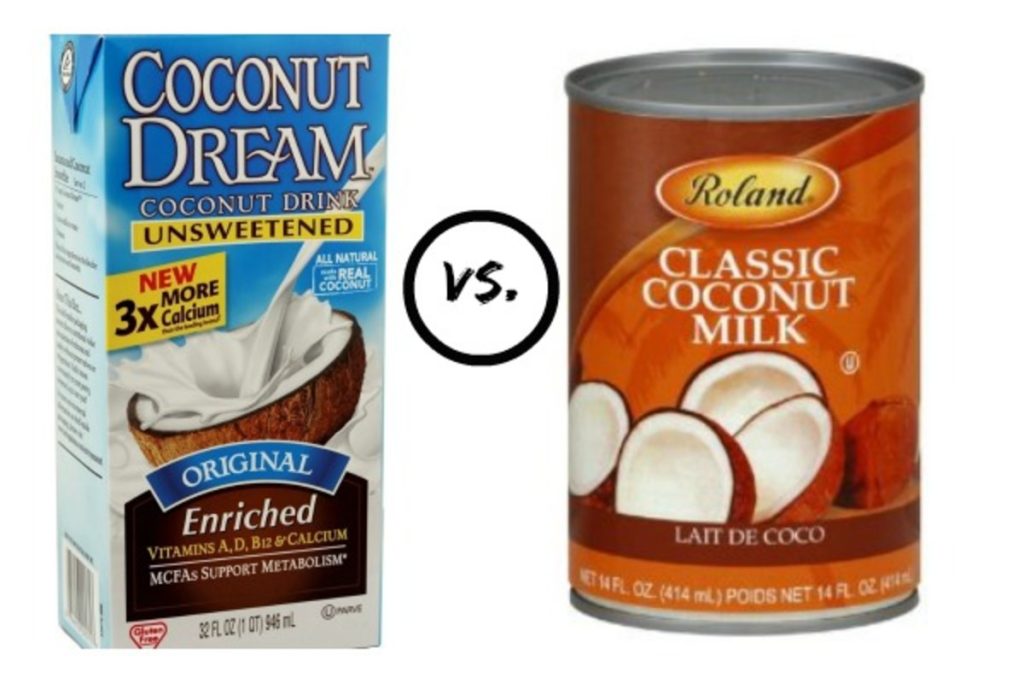
The ingredients in the two products differ quite slightly, yet they both start with coconut and purified water.
The following are the ingredients in canned coconut milk:
Purified water, organic coconut, organic guar gum.
The following are the ingredients in coconut milk from a carton:
Organic coconut milk (filtered water, organic coconut cream), calcium carbonate, natural flavor, organic locust bean gum, gellan gum, sea salt, vitamin a, palmitate, ergocalciferol (vitamin d2), cyanocobalamin (vitamin b12)
Both of these are unsweetened and from the same brand.
The substance from the container, as you can see, has flavors, thickeners, and stabilizing agents added to it. True, the canned coconut contains guar gum, which, like locust bean and gellan gum, is a thickening agent. However, they are most likely utilized in considerably smaller levels in canned food. In addition, the coconut milk carton has substantially higher water content. That’s why it pours out of the carton and why it’s so much less expensive per ounce than the can.
Examining the fat content is the most straightforward approach to determine this.
A can of coconut milk (not the “light” variety) contains 12 grams of fat per 1/3 cup.
However, 1 cup of unsweetened coconut milk contains only 4.5 grams of fat.
There’s 800% more fat in the can than there is in the carton. And it’s because of all the extra water in the carton that isn’t in the can.
The coconut milk carton, on the other hand, has a relatively neutral flavor. If you used the carton instead of the can, the delightful coconut flavor that is so important in Thai curries and soups would be scarcely discernible.
Is coconut milk in a can unsweetened?
Almost all canned coconut milk brands are unsweetened, which means there is no added sugar or sweetener. Coconut, on the other hand, is naturally sweet and heavy in sugar. So, sure, it’s unsweetened most of the time. However, double-checking the ingredients is usually a good idea. Coconut milk in a can isn’t always unsweetened.
Though it’s inherently sweet, it’s also available in a sweetened condensed version and a coconut cream variant. Sugar is added to both sweetened condensed coconut milk and coconut cream.
Almost every recipe that calls for canned coconut milk specifies unsweetened coconut milk. So, while shopping for canned coconut milk, search for the “unsweetened” label just to be sure, or read the ingredients list because some imported coconut milk doesn’t list the ingredients on the front.
Is it okay to use canned coconut milk in a curry?
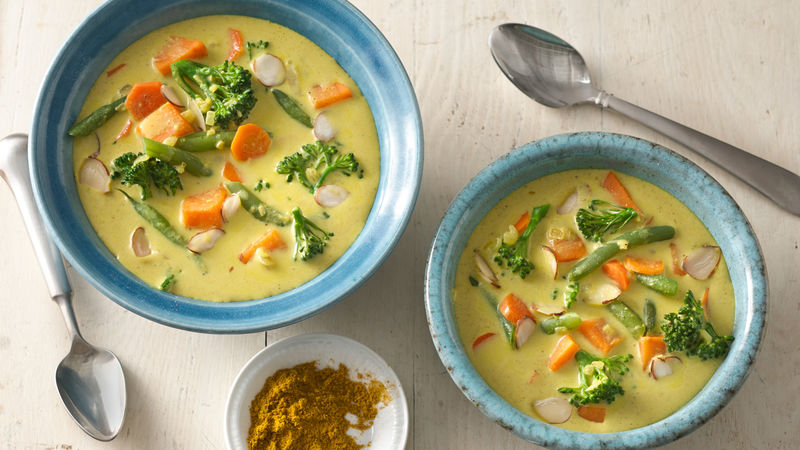
Suppose you enjoy curry. Curry gets its firmness and depth of flavor from canned coconut milk. The coconut milk in the carton lacks a distinct coconut flavor and the consistency of canned coconut milk. That’s because the carton is so watered down, as we discussed earlier.
As a result, using only cartons of coconut milk will result in a watery and flavorless curry.
If my curry (which utilized a can as its base) is a touch thick, I’ve substituted carton coconut milk occasionally. Basically, I use only a tiny amount from the carton to achieve the consistency I like in my curry. Of course, if you’re using coconut milk from a carton, be sure it’s unsweetened. So also, by all means, make sure it’s not flavored with vanilla!
You can cook curry with a carton of unsweetened plain coconut milk if that’s all you have on hand. Keep in mind that you’ll need to use less than you would with the canned option, which will keep it from being overly watery. Prepare to experiment with the quantities of curry paste, fish sauce, chili garlic sauce, and other components. This can help compensate for the carton coconut milk’s lack of coconut flavor.
Can you drink coconut milk from a can?
Coconut milk from a can be used as a beverage. However, it will most likely divide in the can into a solid layer of coconut cream and a watery liquid beneath it. As a result, stirring or mixing is advised. However, it will be thicker and have a more robust flavor than canned coconut milk. Coconut milk is a nutrient-dense beverage. Coconut milk has a number of health benefits, according to a recent study published in the Journal of Chemical and Pharmaceutical Research and a second study published in the Natural Medicine Journal. Coconut milk is known for:
- Assisting in the maintenance of a healthy weight.
- Assisting with heart health in general.
- Aids the immunological system.
That first study explicitly discovered that coconut milk could “prevent oxidative damage and reduce the risk of degenerative diseases.”
It is, however, cumbersome in fat, with one cup containing energy ranging from 350 to 550 calories. It’s also quite thick, which explains why the contents of the carton are so watered down.
While canned coconut milk is fantastic in smoothies, there are a variety of other ways to enjoy coconut milk. A pinch of sugar can be added to add a touch of sweetness to your coffee or tea.
For a sweet dairy-free dessert, combine a bowl of mixed berries with a small amount of coconut milk. For a lovely winter drink, combine cinnamon and vanilla with a tiny amount of warmed coconut milk. With coconut milk, seltzer, natural sweetener, and other savory ingredients you can make a delectable mocktail.
Pour coconut milk onto a popsicle tray with your favorite fruit or other add-ins, freeze, and enjoy some delicious coconut popsicles as a summer treat. Coconut milk is also heavy in potassium and iron, and it’s a fantastic hair conditioner!
When consumed in moderation, coconut milk is a beautiful treat that can help you feel fuller for longer and have more energy.
What is the best way to preserve leftover canned coconut milk?
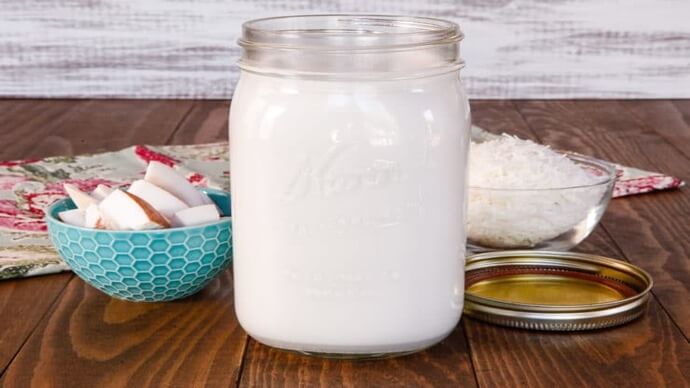
In a tightly sealed airtight container, opened cans of coconut milk should be kept in the refrigerator for 7 to 10 days. Coconut milk cans that haven’t been opened can be kept in your pantry. If you open a can of coconut milk and don’t consume it all, store the remainder in the fridge or freezer. It will, of course, keep for longer in the freezer, but the texture and flavor may alter.
However, it can be kept in the can wrapped in aluminum foil or plastic wrap. However, if you take that route, you should use it within a few days. If you store coconut milk in a sealed Tupperware-style container, it will last for 7 to 10 days in the fridge.
Keep coconut milk away from strong-smelling foods like fish or onions while storing it in the fridge. After a few days, coconut milk will take on the flavors of other nearby meals. Coconut can be kept frozen for up to three months. Coconut milk should be frozen in an airtight container with plenty of room for expansion.
You can also freeze it in ice cube trays for quick access to tiny amounts. Allow them to defrost before drinking or adding to your coffee. You may also blend your smoothie with the coconut milk ice cubes already in it. When you freeze coconut milk, keep in mind that when you defrost it, it will be “broken.”
This indicates that the fat and milk have separated. To return it to its original state for cooking and drinking, simply combine it. As a result, adding frozen coconut milk to a dish that is simmering on the stovetop is not a good idea. Coconut milk, whether frozen or refrigerated, can be kept indefinitely.
How do you tell if coconut milk in a can has gone bad?
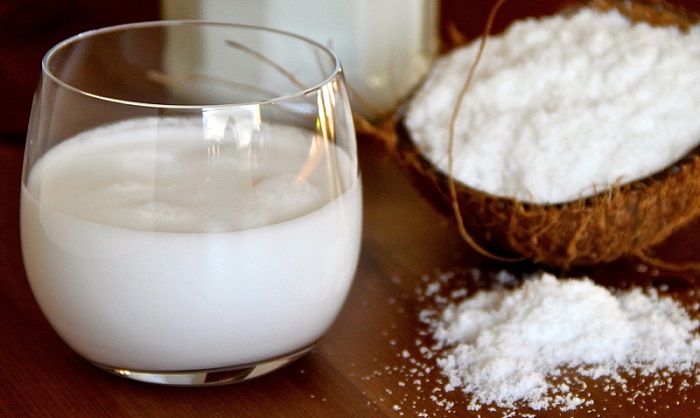
Please give it a sniff to see whether the coconut milk has gone sour. Give it a try if it doesn’t look or smell unpleasant. If it doesn’t taste good, don’t swallow it. It’s OK to consume or cook with coconut milk if it looks, smells, and tastes well. Any coconut milk that looks or smells rotten should be discarded, as should any bulging or corroded cans, regardless of their expiration date. No matter how much you adore curry, there’s no need to risk getting sick.
Is there anything I can use instead of canned coconut milk?
Nothing can completely replace the flavor and consistency of canned coconut milk. Still, there are several alternatives if you don’t have any on hand or have a coconut allergy.
Coconut powder: Coconut powder has a long shelf life. All you have to do is mix it with water to have the same coconut flavor and consistency.
Coconut water: Coconut water has the same flavor as canned coconut milk but it lacks consistency. To thicken it up a little, add some heavy cream.
Heavy cream: Heavy cream won’t have the same coconut flavor as coconut milk, but it will have the same consistency. If you aren’t sensitive to coconut, you can flavor it with some coconut water.
Cream cheese and skim milk are mixed in equal parts: The viscosity of coconut milk will be similar to heavy cream, but the flavor will be missing.
Coconut yogurt in its natural form: The consistency of yogurt is thick and creamy. While any plain (unflavored and unsweetened) yogurt can suffice, a coconut-based yogurt will provide a hint of coconut flavor.
For those who have nut allergies or dairy intolerance, coconut milk is a fantastic alternative. Although, what if you have a coconut allergy or dislike the taste? Fear not if you are allergic to coconut, have a sensitivity to coconut milk, or dislike it! While nothing quite compares to the flavor and smoothness of canned coconut milk, there are a few good alternatives.
What’s the difference between canned coconut milk and coconut cream?
Coconut cream is a thicker and creamier version of coconut milk. The coconut cream is the component of canned coconut milk that rises to the top of the can. Coconut cream, on the other hand, can be purchased separately from coconut milk. It’s created with the same ingredients – coconut and water – but with less water.
It’s a good idea to give the can of coconut milk a thorough shake before using it in a recipe. The coconut cream will combine with the coconut milk if you shake the can. It is because coconut milk and coconut cream have similar flavors, the amount you use depends on the consistency you desire in your recipe. Curry and coconut chocolate mousse both benefit from coconut cream.
Just keep in mind that sweetened or sweetened condensed coconut cream is sometimes available. If you’re going to use it in a curry, get the unsweetened coconut cream.
Have I covered everything you wanted to know about coconut milk and the differences between cans and cartons?
Oh my goodness, coconut water, coconut milk, and coconut cream! We’ve learned a lot about the various varieties of delectable coconut goods today. In conclusion:
The liquid from the coconut is known as coconut water.
Coconut milk is prepared by blending the coconut’s sweet white meat with water and straining it. It tastes well in Indian and Thai dishes. Coconut cream is a thicker and creamier version of coconut milk. The flavor is quite close to coconut milk, and it gives recipes a beautifully thick consistency. We looked into the subject of whether coconut milk in a can is the same as coconut milk in a carton.
No, there isn’t an answer to that question which would allow us to eliminate one over the other as a substitute. They are pretty dissimilar and have their own uses in various recipes. To sum up, coconut milk from a can is not the same as coconut milk from a carton. It’s a lot more watered down, and it lacks the distinct coconut flavor that’s so important in curries and other Thai dishes. Carton coconut milk is acceptable for sipping, coffee creamer, and cereal. Still, it isn’t a good substitute for canned coconut milk in baking or cooking.











